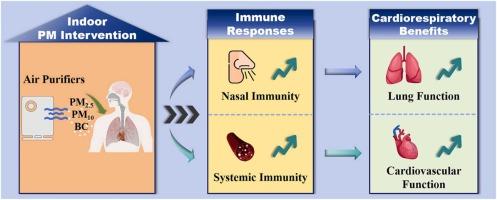减少室内颗粒物对心肺的益处取决于免疫的改善:来自随机、双盲交叉试验的个体异质性见解
IF 11.3
1区 环境科学与生态学
Q1 ENGINEERING, ENVIRONMENTAL
引用次数: 0
摘要
室内空气污染与健康已成为全球一个重大的环境和公共卫生问题。然而,对室内颗粒物(PM)减少的免疫反应的个体异质性及其在心肺益处中的作用仍不清楚。这项随机、双盲交叉试验在中国北京的80名健康大学生中进行,包括两个为期4天的室内空气净化实验(真实和虚假),中间间隔16天的洗脱期。实时监测室内PM水平。在心肺功能评估和空腹采血前一天采集鼻黏膜内层液以检测免疫分子。采用线性混合效应模型估计干预效果。我们发现减少室内PM可显著改善鼻腔和全身免疫,但不能改善整体心肺功能。进一步的个体水平分析揭示了免疫和心肺指标的异质性变化。具体来说,呼吸系统的益处发生在鼻腔免疫改善较大的个体中,而心血管的益处主要取决于全身免疫的改善。在鼻腔和全身免疫改善的个体中观察到呼吸和心血管的益处。值得注意的是,即使室内PM浓度低于世卫组织空气质量准则,进一步减少PM暴露仍然可以改善免疫。这些发现支持针对个体免疫敏感性对室内PM污染进行精确干预。本文章由计算机程序翻译,如有差异,请以英文原文为准。

Cardiorespiratory benefits of reducing indoor particulate matter depend on immune improvements: Insights into individual heterogeneity from a randomized, double-blind crossover trial
Indoor air pollution and health have emerged as a significant environmental and public health concern globally. However, individual heterogeneity in immune response to indoor particulate matter (PM) reduction and its role in cardiorespiratory benefits remain unclear. This randomized, double-blind crossover trial was performed among 80 healthy college students in Beijing, China, including two 4-day indoor air purification sessions (real and sham), separated by a 16-day washout period. Real-time indoor PM levels were monitored. Nasal mucosal lining fluid was collected one day before cardiorespiratory assessments and fasting blood collection to detect immune molecules. Linear mixed-effect models were used to estimate intervention effects. We found reducing indoor PM significantly improved nasal and systemic immunity, but not overall cardiorespiratory function. Further individual-level analysis revealed heterogeneous changes in immune and cardiorespiratory indicators. Specifically, respiratory benefits occurred in individuals with greater nasal immunity improvements, while cardiovascular benefits primarily depended on improvements in systemic immunity. Both respiratory and cardiovascular benefits were observed in individuals with improvements in both nasal and systemic immunity. Notably, even when indoor PM concentrations were below WHO air quality guidelines, further reducing PM exposure still yielded immune improvements. These findings support precision interventions in indoor PM pollution tailored to individual immune sensitivity.
求助全文
通过发布文献求助,成功后即可免费获取论文全文。
去求助
来源期刊

Journal of Hazardous Materials
工程技术-工程:环境
CiteScore
25.40
自引率
5.90%
发文量
3059
审稿时长
58 days
期刊介绍:
The Journal of Hazardous Materials serves as a global platform for promoting cutting-edge research in the field of Environmental Science and Engineering. Our publication features a wide range of articles, including full-length research papers, review articles, and perspectives, with the aim of enhancing our understanding of the dangers and risks associated with various materials concerning public health and the environment. It is important to note that the term "environmental contaminants" refers specifically to substances that pose hazardous effects through contamination, while excluding those that do not have such impacts on the environment or human health. Moreover, we emphasize the distinction between wastes and hazardous materials in order to provide further clarity on the scope of the journal. We have a keen interest in exploring specific compounds and microbial agents that have adverse effects on the environment.
 求助内容:
求助内容: 应助结果提醒方式:
应助结果提醒方式:


